
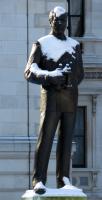
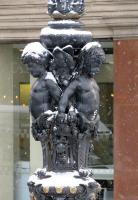
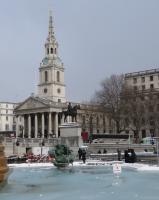
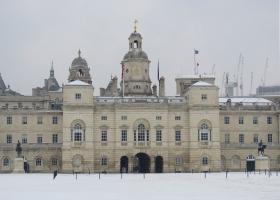
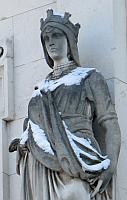
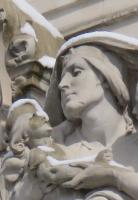
The fine snowfall on 28 Feb and 1 March has given a nice subject for this month: statues and snow. I took a modest walk around Westminster to take these pictures. We start on the Mall, for a walk along the edge of St James Park, then up Whitehall to Trafalgar Square, then cutting along Northumberland Avenue to return via a part of the Victoria Embankment, and thence to Westminster Station where the walk ends.
Queen Alexandra memorial, by Alfred Gilbert: snow accentuating composition.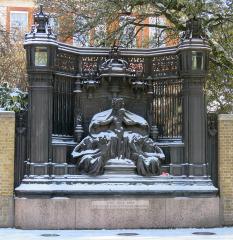
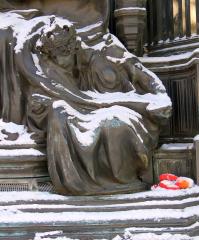
There are two beautiful art nouveau pieces of sculpture on the north side of St James Park. The first, to the western end of the Mall, a few paces along Marlborough Road towards St James's Palace and Pall Mall. it depicts Queen Alexandra, with three attendant figures, a composition united by great whorls of drapery, accentuated by the snow. The otherworldly faces are set off nicely by the wintry coat of snowflakes, a magical and dreamlike setting. The group is a late work of the sculptor Alfred Gilbert, best known of course for the Statue of Eros (see this page).
Westmacott's Duke of York, and St James's Park Terrace by John Nash.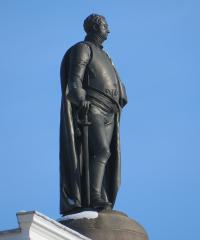
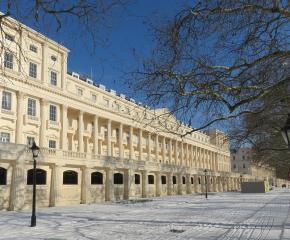
Proceeding eastwards, the low spring sun and the reflection from the snow gives an extra brightness to the frontage of the Nash Terraces: there are two ranges, with the Royal Society and the British Academy and other worthy institutions to the other side, and the Institute of Contemporary Arts on this side, facing the Park. No snow is to be seen on the statue of the Duke of York on his column, just a tiny smidgen on the globe on which he stands. Sir Richard Westmacott RA was the sculptor, and Benjamin Wyatt, of a prolific and gifted family of architects and sculptors, designed the column.
Boer War Memorial for the Royal Artillery, by W.R. Colton.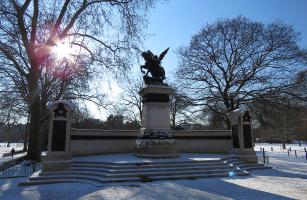
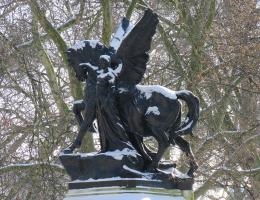
Now to our second piece of art nouveau sculpture. On the south side of the Mall towards the eastern end is the Boer War Memorial to the Royal Artillery. The centrepiece is the group of a female figure walking with a winged horse or Pegasus, excellent work by the sculptor W.R. Colton. Here, the snow lies on the few more horizontal surfaces from this group based on anged and vertical lines: the woman's head and shoulders and breasts, and the Pegasus's mane, raised foreleg and back.
The eastern side of St James's Park encompasses the huge Horse Guards Parade ground, nice and white, with the fantastic backdrop of Horseguards itself, and the buildings along Whitehall. Goscombe John's equestrian statue of Viscount Wolseley takes the snow well, showing how good the black statues go with the whiteness. On the other side of the entrance through to Whitehall stands the second statue on horseback, Harry Bates's Lord Roberts, where the snow emphasises the restless surface of the sculpture.
Snow-covered equestrian statues and Wellington's Cadiz gun, Horse Guards Parade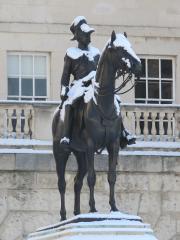
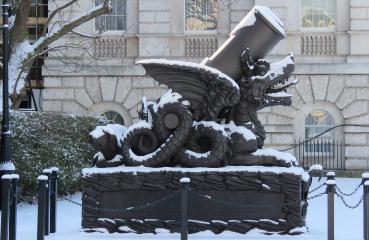
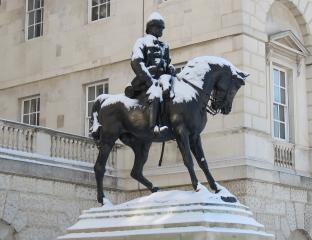
Wellington's Cadiz Gun nearby gives a satisfying spikiness, with the snow again emphasising the effect. There was not so much snow on this occasion on the statue of Kitchener of Khartoum, but Mountbatten, a modern piece by Franta Belsky, is improved by the mantle of whiteness - a picture is shown at the top of this page.
Foreign and Commonwealth statues towards St James's Park, a little snow on pale stone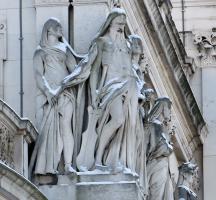
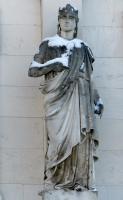

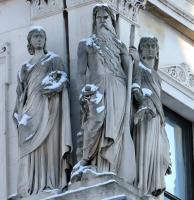
Proceeding eastwards, Clive of India on this occasion is bereft of snow, but the allegorical statues of rivers high up on the rear of the Foreign and Commonwealth Office had a modest smattering. On the other side, the lodge by the St James's Park lake is given added picturesqueness.
After the Foreign Office and the Treasury building, we can turn left, or eastwards, and pass on the north side of Parliament Square, to which we shall return later, and proceed up Whitehall (lots of pictures of Whitehall statuary without snow are on this page). Lutyens' Cenotaph is too pale to show the snow, but the reflected light increases the brightness and makes the flags stand out. Various statues stare down from the balustrade of the Municipal Buildings on the corner, the work of the sculptor Bertram Mackennal, too exposed to bear more than a few snowy highlights. The King Charles Street bridge however is a windtrap and the two groups are more thickly mantled, the pale statues appearing to have emerged from white dust. Paul Montford was the sculptor.
Snow on pale stone in Whitehall.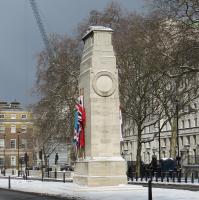
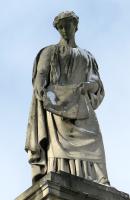
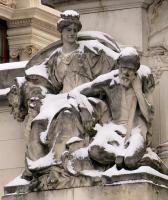
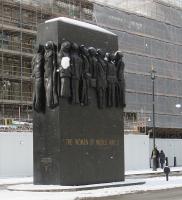
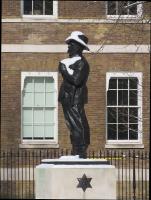 Snow on modern black statuary: Women of WW2, and Viscount Slim.
Snow on modern black statuary: Women of WW2, and Viscount Slim.
Further up Whitehall, we are back to the more satisfying contrast of black statues and white snow, where even a slight daubing of white is noticeable. The Women of World War II memorial is a very modern work by John W. Mills. Uncomfortable with the idea of having statues of actual women, it consists of a monolith with just the uniforms of women workers of the time. The monolith is topped off with snow, and the odd patch maintains a slippery grip on the sculptural portions. The Ministry of Defence's taste in statues is not one I share to any degree, but even the statue of Field Marshall Viscount Slim, one of a couple of statues on the Whitehall side of the building by Ivor Roberts-Jones, can see an improvement by the addition of snow: would that the rest of the statue had been obscured too. The sculptor can be forgiven only because of his greatly superior statue of Churchill in Parliament Square.
Nelson from Whitehall, not much snow.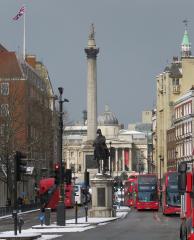
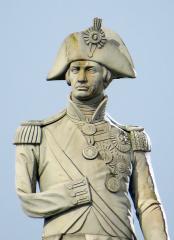
On this occasion, other statues along Whitehall also have only a little snow, though I cannot resist a picture of one of Alfred Drury's superior groups on the Old War Office - see top of the page for a picture. But even a small amount of snow makes the view up Whitehall to Nelson's Column most satisfying, though the statue by Edward Hodges Baily of Nelson himself shows a sliver of snow on one arm and almost no snow on his hat. More on Nelson on this page.
Carrying on into Trafalgar Square, the number of cars going past seems enough to warm the snow to the pint of melting, and only a few chilly ribbons can be seen. Yet the statue of Charles I, the important statue by Hubert le Sueur, is surrounded by snow, though the rounded curves typical of the sculptor's works give little purchase for snow on the statue itself, excepting the back of the horse.
The famous Landseer Lions (lots of pictures on this page) manage enough snow to give that good juxtaposition of black and white we have become accustomed to, the scale of the lions and their pose giving both support for massed snow, and ample opportunity for small snowdrifts to pile up next to their bodies. Here are a few more pictures: the fountain, eerily frozen with the mermaids and mermen by McMillan and Wheeler having both snow and their own icicles; a close up of one of the dolphins; and the panel showing the Horses of the Sun high up on a building frontage, where the snow accentuates the lines of the relief panel. There is an ornate lampstand near to Charles I, prettily decorated with snow, and a picture of the cherubs on the shaft of this is at the top of the page.
Snow and ice and the Trafalgar Square sculpture.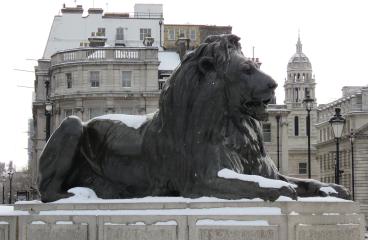
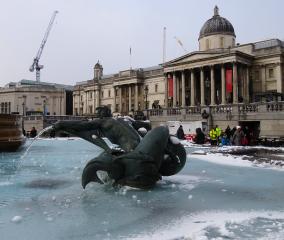

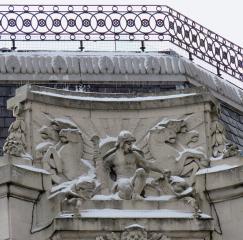
From Trafalgar Square, we take the short walk along Northumberland Avenue through to the Embankment, and turn right to return to Parliament Square. This part of the Embankment has one of the Victoria Embankment Gardens, outstandingly beautiful in the snow, with the spiky buildings of Whitehall Court and the National Liberal Club behind, and several statues on tall plinths, which because of the sheltered position, manage to hold a little snow. Here is a picture of Bartle Frere, by Thomas Brock, and a little further along, William Tyndale by J.E. Boehm, a persona favorite of mine among the statues on this part of the Embankment.
Victoria Embankment, and two of the statues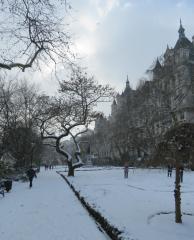
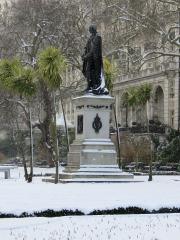
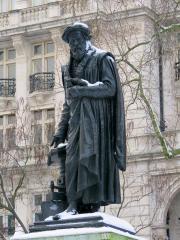
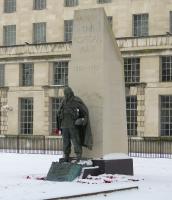
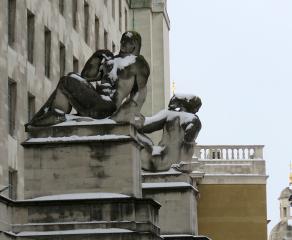 Korean War Memorial, Earth and Water.
Korean War Memorial, Earth and Water.
Boadicea, by Thomas Thornycroft.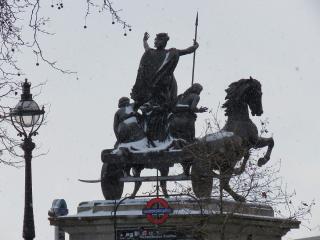
This site includes a few pages on other statues in the snow: the Albert Memorial, the Victoria Memorial, and the Great Exhibition Memorial.
Back to February // Onward to April
Visits to this page from 3 Mar 2018: 3,520